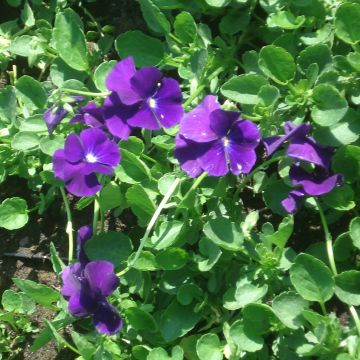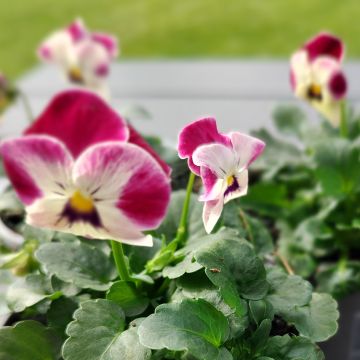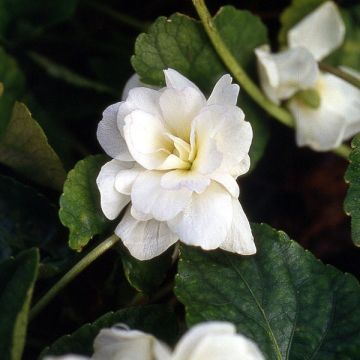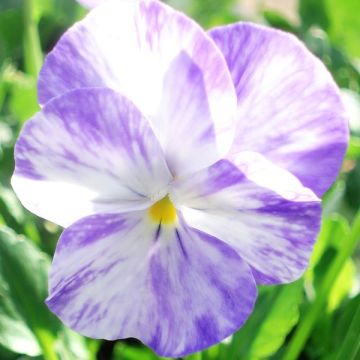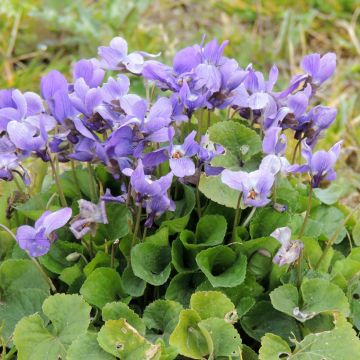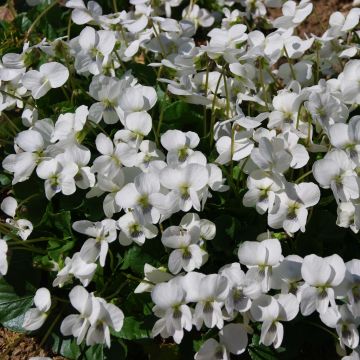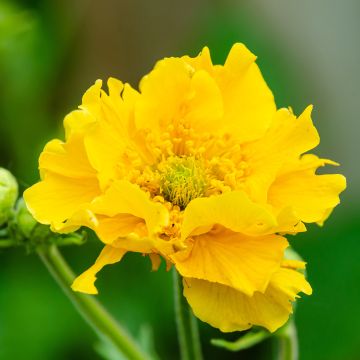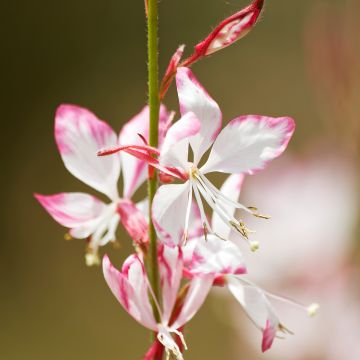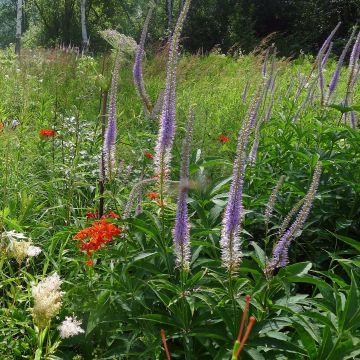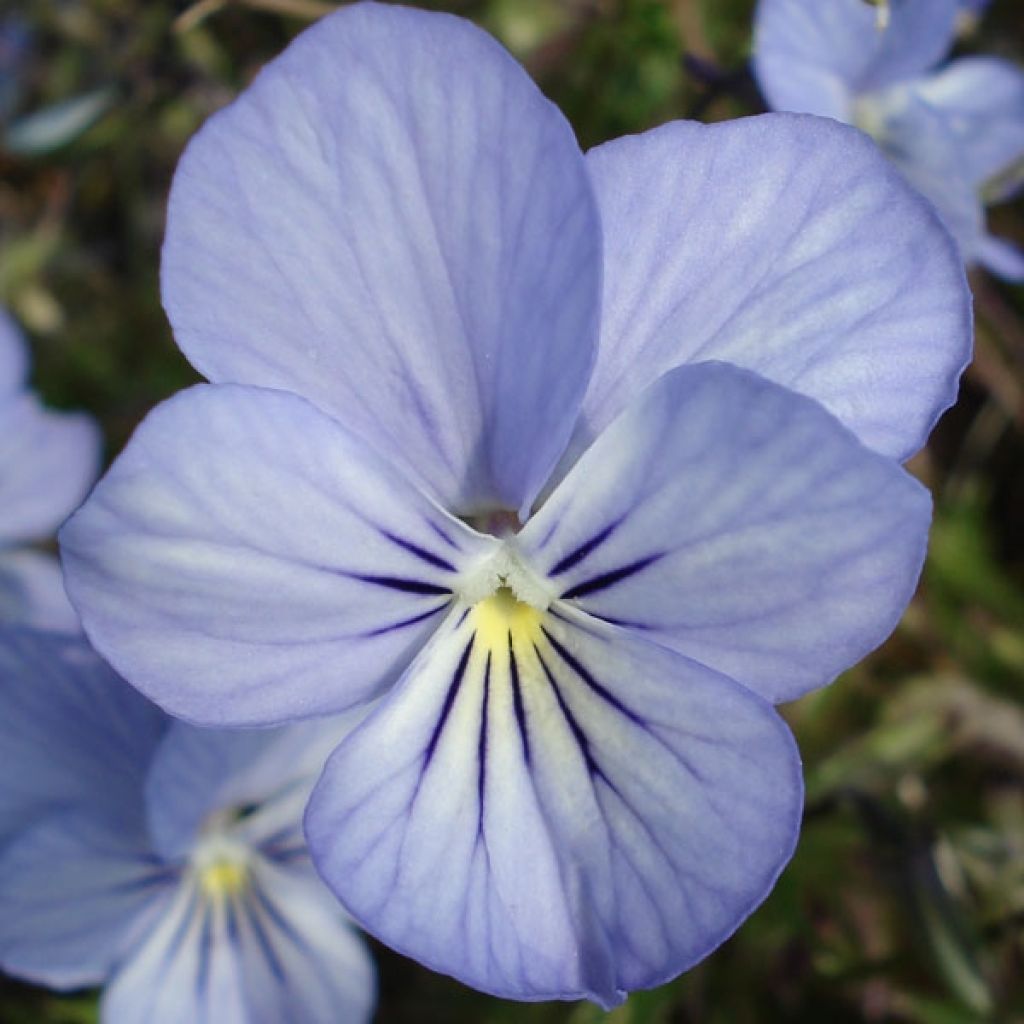

Viola cornuta Icy but spicy


Viola cornuta Icy but spicy
Viola cornuta Icy but spicy
Viola cornuta Icy but spicy
Horned Pansy, Horned Violet
This item cannot be shipped to the selected country
Delivery charge from €5.90
More information
Schedule delivery date,
and select date in basket
This plant carries a 12 months recovery warranty
More information
We guarantee the quality of our plants for a full growing cycle, and will replace at our expense any plant that fails to recover under normal climatic and planting conditions.
From €5.90 for pickup delivery and €6.90 for home delivery
Express home delivery from €8.90.

Does this plant fit my garden?
Set up your Plantfit profile →
Description
Viola Cornuta Icy but spicy is a creeping biennial with a flared rosette tuft and upright stems that behaves like a perennial. From April to September, it has a continuous and exceptionally long flowering period due to the succession of spontaneous seedlings. This perennial produces an abundance of flowers measuring 2 to 4cm (1 to 2in) in diameter with petals ranging from pale blue to deeper violet. The lower petals are speckled with white and bear a short spur measuring 1 to 2cm (1in) long. The flowers are slightly fragrant.
The Horned Violet, native to the Spanish Pyrenees, reaches a height of 15cm (6in) and a width of 40cm (16in). It has evergreen green foliage. The leaves, measuring 2 to 5cm (1 to 2in) in length, are ovate with toothed margins. Due to its high cold resistance, the Viola Cornuta can last for several seasons. It has rapid growth and excellent coverage. It is ideal for surrounding a bush, for example, or covering unused areas of land.
The Viola Cornuta can be placed in pots or planters due to its long flowering period and ease of cultivation. Additionally, it makes a magnificent decorative ground cover and can be used as a carpet to conceal bare soil. It also works well in flowerbeds, borders, rockeries, or even woodland areas. It pairs perfectly with spring bulbs such as snowdrops, daffodils, or crocuses, as well as shrubs and perennials. It is a filler plant. The horned pansy closely resembles a regular pansy but with smaller flowers. Its name Viola refers to pansies and violets in Latin. It originates from the Greek word 'ion', which is the name of a tiny violet flower.
Report an error about the product description
Viola cornuta Icy but spicy in pictures




Flowering
Foliage
Plant habit
Botanical data
Viola
cornuta
Icy but spicy
Violaceae
Horned Pansy, Horned Violet
Other Viola - Violets
Planting and care
Place Viola Cornuta in full sun or partial shade, sheltered from intense sunlight and dry winds. Plant it in a fertile, humus-rich, moist but well-drained soil during spring or autumn. It tolerates limestone and ordinary soils. It is a nutrient-hungry plant, so it needs to be fed with liquid fertiliser for containers once or twice a week during the growing season. Water regularly but not excessively. The Horned Violet is easy to cultivate. Protect it from excessive winter moisture. Remove faded flowers to encourage more flowering. After flowering, prune to maintain a compact habit. However, the mother plant is often discarded as numerous spontaneous seedlings will appear. Beware of slugs and snails, as well as aphids, red spider mites, and violet gall midges. Protect the plant from black spot, rust, and powdery mildew.
Planting period
Intended location
Care
-
, onOrder confirmed
Reply from on Promesse de fleurs
Summer flowering perennials
Haven't found what you were looking for?
Hardiness is the lowest winter temperature a plant can endure without suffering serious damage or even dying. However, hardiness is affected by location (a sheltered area, such as a patio), protection (winter cover) and soil type (hardiness is improved by well-drained soil).

Photo Sharing Terms & Conditions
In order to encourage gardeners to interact and share their experiences, Promesse de fleurs offers various media enabling content to be uploaded onto its Site - in particular via the ‘Photo sharing’ module.
The User agrees to refrain from:
- Posting any content that is illegal, prejudicial, insulting, racist, inciteful to hatred, revisionist, contrary to public decency, that infringes on privacy or on the privacy rights of third parties, in particular the publicity rights of persons and goods, intellectual property rights, or the right to privacy.
- Submitting content on behalf of a third party;
- Impersonate the identity of a third party and/or publish any personal information about a third party;
In general, the User undertakes to refrain from any unethical behaviour.
All Content (in particular text, comments, files, images, photos, videos, creative works, etc.), which may be subject to property or intellectual property rights, image or other private rights, shall remain the property of the User, subject to the limited rights granted by the terms of the licence granted by Promesse de fleurs as stated below. Users are at liberty to publish or not to publish such Content on the Site, notably via the ‘Photo Sharing’ facility, and accept that this Content shall be made public and freely accessible, notably on the Internet.
Users further acknowledge, undertake to have ,and guarantee that they hold all necessary rights and permissions to publish such material on the Site, in particular with regard to the legislation in force pertaining to any privacy, property, intellectual property, image, or contractual rights, or rights of any other nature. By publishing such Content on the Site, Users acknowledge accepting full liability as publishers of the Content within the meaning of the law, and grant Promesse de fleurs, free of charge, an inclusive, worldwide licence for the said Content for the entire duration of its publication, including all reproduction, representation, up/downloading, displaying, performing, transmission, and storage rights.
Users also grant permission for their name to be linked to the Content and accept that this link may not always be made available.
By engaging in posting material, Users consent to their Content becoming automatically accessible on the Internet, in particular on other sites and/or blogs and/or web pages of the Promesse de fleurs site, including in particular social pages and the Promesse de fleurs catalogue.
Users may secure the removal of entrusted content free of charge by issuing a simple request via our contact form.
The flowering period indicated on our website applies to countries and regions located in USDA zone 8 (France, the United Kingdom, Ireland, the Netherlands, etc.)
It will vary according to where you live:
- In zones 9 to 10 (Italy, Spain, Greece, etc.), flowering will occur about 2 to 4 weeks earlier.
- In zones 6 to 7 (Germany, Poland, Slovenia, and lower mountainous regions), flowering will be delayed by 2 to 3 weeks.
- In zone 5 (Central Europe, Scandinavia), blooming will be delayed by 3 to 5 weeks.
In temperate climates, pruning of spring-flowering shrubs (forsythia, spireas, etc.) should be done just after flowering.
Pruning of summer-flowering shrubs (Indian Lilac, Perovskia, etc.) can be done in winter or spring.
In cold regions as well as with frost-sensitive plants, avoid pruning too early when severe frosts may still occur.
The planting period indicated on our website applies to countries and regions located in USDA zone 8 (France, United Kingdom, Ireland, Netherlands).
It will vary according to where you live:
- In Mediterranean zones (Marseille, Madrid, Milan, etc.), autumn and winter are the best planting periods.
- In continental zones (Strasbourg, Munich, Vienna, etc.), delay planting by 2 to 3 weeks in spring and bring it forward by 2 to 4 weeks in autumn.
- In mountainous regions (the Alps, Pyrenees, Carpathians, etc.), it is best to plant in late spring (May-June) or late summer (August-September).
The harvesting period indicated on our website applies to countries and regions in USDA zone 8 (France, England, Ireland, the Netherlands).
In colder areas (Scandinavia, Poland, Austria...) fruit and vegetable harvests are likely to be delayed by 3-4 weeks.
In warmer areas (Italy, Spain, Greece, etc.), harvesting will probably take place earlier, depending on weather conditions.
The sowing periods indicated on our website apply to countries and regions within USDA Zone 8 (France, UK, Ireland, Netherlands).
In colder areas (Scandinavia, Poland, Austria...), delay any outdoor sowing by 3-4 weeks, or sow under glass.
In warmer climes (Italy, Spain, Greece, etc.), bring outdoor sowing forward by a few weeks.

































